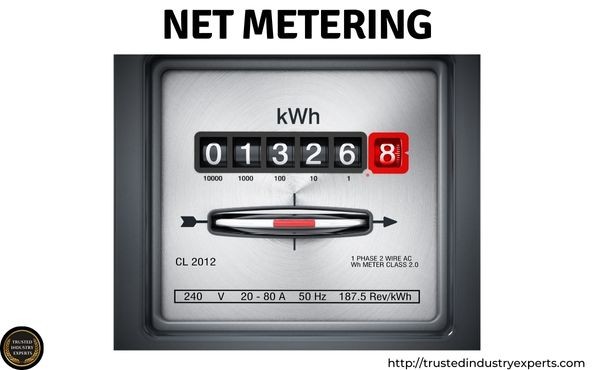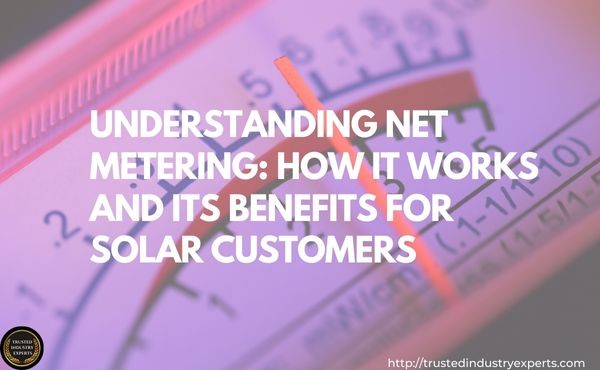Net metering

Net metering is an important concept that has gained a lot of attention in recent years, particularly in the field of renewable energy. It is a billing arrangement that allows customers who generate their own electricity from solar power or other sources to feed any excess energy back into the grid and receive credit for it. This credit can then be used to offset the cost of electricity that is consumed from the grid during periods when the customer’s own electricity generation is insufficient.
What is Net Metering?
Net metering is a billing arrangement that allows customers with solar panels or other renewable energy systems to receive credit for excess electricity that they generate and feed back into the grid. In essence, net metering enables customers to offset the cost of electricity that they draw from the grid with credits that they earn by generating excess electricity during periods when their renewable energy systems are generating more electricity than they need.
Understanding Net Metering: How It Works and Its Benefits for Solar Customers

The use of solar panels is becoming more popular nowadays, as it not only helps reduce carbon footprint but also helps customers save on their electricity bills. However, customers with solar systems often generate more energy than they need, especially during peak sunlight hours. This excess energy can either be stored in batteries or fed back into the electric grid. In this blog post, we will discuss how net metering works and its benefits for solar customers.
Net metering
Net metering is a billing arrangement that allows customers with solar panels or other renewable energy systems to receive credit for excess electricity that they generate and feed back into the grid. It enables customers to offset the cost of electricity that they draw from the grid with credits that they earn by generating excess electricity during periods when their renewable energy systems are generating more electricity than they need.
The excess energy generated by solar panels is sent back to the electric grid, and the customer receives a credit on their electricity bills for the amount of energy generated. This means that when the solar panels are not generating electricity, customers can draw electricity from the grid and use their credits to offset their electricity bills.
The net metering program varies by state, and the Solar Energy Industries Association (SEIA) recommends checking state-specific policies as it can differ from state to state. Some states offer retail net metering, where customers are credited at the retail rate, while others offer what is called “wholesale” net metering where customers are credited at the lower wholesale rate.
Solar customers can lower their energy bills by producing their electricity, thanks to net metering. This system enables customers to accumulate credits for any excess energy generated by their solar panels. These credits can then be applied to offset their energy bills. This means that customers can save money on their electricity bills while also reducing their carbon footprint.
Another benefit
Another benefit of net metering is that it helps reduce the strain on the electric grid during peak periods. Instead of relying on energy from traditional power plants during peak periods, net metering allows solar customers to feed excess energy into the grid, reducing the strain on the grid and ensuring a more stable supply of electricity during peak periods.
Solar customers benefit from net metering agreements by generating surplus energy, receiving credits, and reducing the electric grid’s load. This arrangement permits customers with solar power systems to save money and reduce their expenses. Additionally, net metering improves the grid’s efficiency and increases the use of renewable energy. Research net metering policies and collaborate with trustworthy solar companies to maximize net metering benefits.
How does Net Metering Work?

Net metering works by tracking the amount of electricity that a customer’s renewable energy system generates and the amount of electricity that the customer consumes from the grid. When a renewable energy system produces extra electricity, it is sent back to the grid and the customer gets credits. These credits can offset the cost of electricity the customer uses when their system cannot generate enough. The excess electricity contributes to a cleaner grid and reduces carbon emissions. Customers can use renewable energy while saving money and promoting sustainability.
Understanding the Basics of Net Metering: A Guide for Homeowners

Are you interested in installing a rooftop solar system to generate your electricity? Do you want to offset the cost of electricity bills by tapping into renewable energy sources? If yes, then you need to understand the basics of net metering. Net metering credits homeowners for excess electricity sent to the grid. It’s a favorable practice. This process helps with the distribution of electricity, and rewards those who generate extra energy. Homeowners can benefit from solar panels and wind turbines, as they can generate excess energy. The surplus energy is then fed to the grid, and homeowners earn credits on their bills.
1. The Working of Net Metering:
Net metering works by tracking the amount of electricity that a customer’s renewable energy system generates and the amount of electricity that the customer consumes from the grid. This process involves the installation of a special electric meter that can monitor the flow of electricity in both directions. When a customer’s renewable energy system produces surplus electricity, it is transferred back to the grid, and they receive credits for it. These credits are used to offset the cost of electricity during periods of low renewable energy generation. This innovative system benefits both the customer and the grid.
2. Mandatory Net Metering Rules:
Many states have passed mandatory net metering rules that require electric utilities to offer net metering to their customers. Renewable energy systems are expensive at first, but net metering can make them affordable for customers. This can encourage customers to produce their own electricity, reducing the need for new facilities and strain on the grid for utilities. As a result, it helps to minimize the cost of new power plants and transmission lines.
3. Virtual Net Metering:
Virtual net metering is a concept that allows utility customers to get credits for more electricity generated by renewable energy systems installed at different locations. This system is beneficial for those who cannot generate their electricity, such as renters or homeowners with shaded rooftops. The virtual net metering program enables these customers to purchase a share of a distributed generation system and receive credits for the electricity their share generates.
4. Net Metering Credits and Benefits:
The primary benefit of net metering is that homeowners can earn credits by generating electricity, thus reducing their utility bills. Additionally, net metering policies act as a stimulus for the growth of renewable energy generation systems. Homeowners who install rooftop solar systems can lower their carbon footprint, reduce their dependence on fossil fuels and contribute to a greener environment.
5. The Future of Net Metering:
Net metering laws are evolving rapidly to encourage the adoption of renewable energy sources. As of today, 38 states in the US have enacted some form of net metering law, benefiting millions of homeowners. However, the future of net metering is uncertain. Some states have proposed changes that could weaken or eliminate net metering incentives.
Net metering is a fantastic way for homeowners to offset their electricity bills by generating and feeding excess solar to the grid. It encourages the adoption of renewable energy sources, thus reducing reliance on fossil fuels and contributing to a greener environment. As the world looks forward to a more sustainable future, homeowners can play a significant role in making it happen by embracing net metering policies.
Benefits of Net Metering:
Net metering offers several benefits to both customers and utilities. For customers, net metering provides a financial incentive to invest in renewable energy systems, as they can earn credits for more electricity that they generate and feed back into the grid. Renewable energy systems become more accessible for customers as net metering offsets installation costs. Generating their own electricity reduces grid burden and lessens demand for new power plants and transmission lines.
Understanding Net Metering – The Benefits for Customers and Utilities
There has never been a better time to invest in renewable energy systems for homes, businesses and communities. Not only is investing in renewable energy good for the environment, it can also help reduce monthly electric bills, especially for those who adopt net metering. Customers can send their own electricity to the grid and receive financial rewards from net metering programs. These incentives encourage investment in renewable energy systems, like solar panels. Net metering benefits both customers and utilities, driving the continued growth of solar energy.
1) Net Metering Benefits for Customers:
One of the most significant benefits of net metered is that it allows customers to generate their own electricity from clean and renewable sources, like wind and solar. This, in turn, can help reduce energy costs over time. With net meter, customers can pull electricity from the grid when their renewable systems are not generating enough electricity, and the surplus energy generated is fed back into the grid, allowing them to earn credits. These credits are then applied to their monthly electric bills, offsetting the cost of purchasing electricity from the electric company. Moreover, net metering work that allows homeowners to sell excess power to utilities at the retail rate, providing a financial incentive for them to produce more energy than they use.
2) Utilities Benefit from Net Metering:
Utilities also stand to benefit from net metering. By encouraging customers to generate their own electricity, utilities can reduce the strain on the electrical grid. It can help reduce the need for new power plants and transmission lines, leading to long-standing cost savings. Furthermore, net metering promotes the growth of solar energy, which can help states meet their renewable energy targets.
3) Community Solar and New Solar Customers:
Community programs are another example of how net metering and net energy is driving the growth of solar energy. People who cannot install solar panels on their homes can still access renewable energy. Community solar programs lease nearby panels for individual use, allowing them to generate their energy and receive credits. The process enables people to benefit from clean energy without land or financial limitations. It’s a sustainable and cost-effective solution that promotes a more responsible and environmentally conscious lifestyle. This program helps new solar customers to get started with renewable energy irrespective of their ability to install panels themselves.
4) Net Metering Protocols and Regulations:
While net metering is growing in popularity across the country, not all states have adopted it. The California Public Utilities Commission (CPUC) has been a leader in promoting net metering policies, and many other states are following suit. States have diverse rules and regulations for net metering, with limitations such as installation caps and timing of billing cycles. It’s crucial to check your state’s net metering and energy protocol before investing in renewable energy. This ensures compliance with local regulations and maximizes savings. Research and planning can lead to significant financial and environmental benefits when investing in clean energy.
Net metering offers several benefits for both customers and utilities, by providing a financial incentive to invest in renewable energy systems, and helping to reduce the strain on the electrical grid. Net metering has the power to change energy generation and consumption. Renewable energy sources allow customers to produce their own electricity and receive credit for excess energy sent to the grid. This approach has the potential to transform the energy sector. Investing in renewable energy through net metering is not only good for the environment, but also for your pocketbook.
Net Metering and the Environment:
Net metering also has significant environmental benefits. By enabling customers to generate their own electricity from renewable energy sources, net energy metering can help to reduce greenhouse gas emissions and combat climate change. It also promotes the use of clean energy and helps to reduce our reliance on fossil fuels.
Renewable energy customers can revolutionize electricity generation with net metering. They earn credits for excess power supplied to the grid. This concept empowers individuals to create their own electricity using solar panels or wind turbines. The Net metering has immense potential for shaping a clean energy future. This approach encourages investment in renewable energy and decreases dependence on fossil fuels. When contemplating a renewable energy system, it is crucial to grasp net metering’s workings and advantages.



